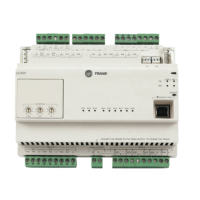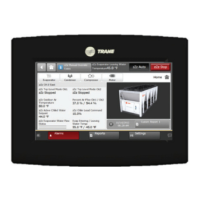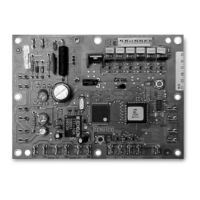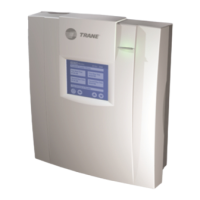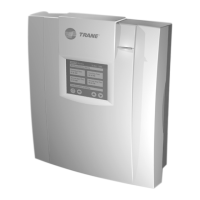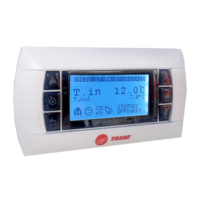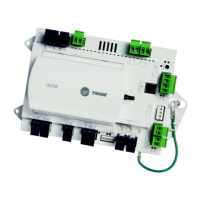54 CNT-SVX17G-EN
Sequence of Operations
CO2-based demand-control ventilation procedure
CO
2
-based demand-control ventilation uses the communicated space CO
2
value. The
controller cannot monitor CO
2
from a local CO
2
sensor. The controller compares the
space CO
2
concentration to the configured band of CO
2
values and determines the
demand ventilation rate of the zone. The resulting ventilation rate is called the effective
ventilation setpoint. The effective ventilation setpoint is the outdoor airflow required to
provide ventilation. It is used to calculate the ventilation ratio of the zone. Table 36
out
line
s the derivation of the outdoor air requirement.
Table 36.Calculation of reported effective ventilation setpoint for CO
2
-based DCV zones
Communicated space CO
2
Reported effective
ventilation
setpoint
Description
Less than configured space
CO
2
low limit
Configured standby-
ve
ntilation setpoint
Zone CO
2
concentration is low. Zone is most likely unoccupied.
Contaminants come from the zone itself (carpet, furniture, paint,
etc.). A minimum of ventilation air is required to ventilate the
zone.
More than configured space
CO
2
high limit
Communicated
ve
ntilation setpoint
limited by
configuration
a
Zone CO
2
concentration is high. Zone is most likely at maximum
designed occupancy. Contaminants come from people and
building sources. A maximum of ventilation air is required to
ventilate the zone.
Configured space CO
2
low
limit communicated space
CO
2
configured space CO
2
high limit
Linear modulation
be
tween configured
standby-ventilation
setpoint and
communicated
ventilation setpoint
limited by
configuration
a
Zone CO
2
concentration is mid-range. Zone is most likely at partial
occupancy. Contaminants come from people and building sources.
However, zone is not at maximum design occupancy and does not
need maximum design ventilation.
b
The communicated space CO
2
value must fall between the configured space CO
2
high
limit and the configured space CO
2
low limit. The reported effective ventilation setpoint
must fall between the configured ventilation setpoint and the configured standby-
ventilation setpoint. If the configured space CO
2
high limit is less than or equal to the
configured space CO
2
low limit, the reported effective ventilation setpoint is equal to the
configured standby-ventilation setpoint.
a. If the value of the communicated ventilation setpoint is valid, it is used but it is limited by the configuration: Configured
standby-ventilation setpoint Communicated ventilation setpoint Configured ventilation setpoint.
b. Reported effective ventilation setpoint = Configured standby-ventilation setpoint + (Communicated space CO
2
– Configured
space CO
2
low limit) * Communicated ventilation setpoint limited by configuration: Configured standby-ventilation setpoint ÷
(Configured space CO
2
high limit – configured space CO
2
low limit).

